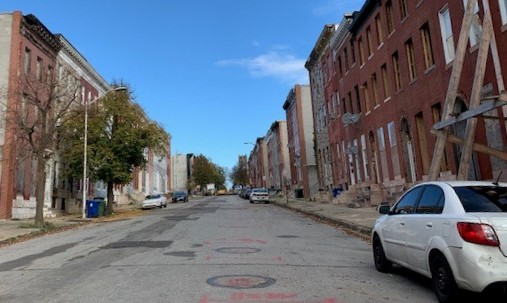



Baltimore has made progress on vacant property reclamation in recent years. But the city still has nearly 15,000 houses with Vacant Building Notices (VBNS), and nearly nine out of 10 of them are located in areas with high concentrations of both vacancy and poverty. These vacant properties, often abandoned, create instability both in the real estate market and the surrounding communities and perpetuate a cycle of disinvestment and population decline. They also cost the city over $200 million annually in lost revenue and direct expenses.
A new approach is needed that looks beyond vacancy and is capable of achieving the health of entire blocks and groups of blocks throughout the city, but especially in West Baltimore, East Baltimore, and Park Heights. Baltimore can do this by securing and deploying substantial and sustained public capital in an equitable manner – one that seeks to restore whole blocks and insists on healthy neighborhoods for all Baltimoreans.
Commissioned by ReBUILD Metro and Baltimoreans United in Leadership Development (BUILD), and supported by funding from the Abell and Robert W. Deutsch foundations, this report by czb analyses Baltimore’s vacant properties and offers strategies to address them. What it finds is a sobering reality check. These vacant buildings and lots do not exist in isolation, and disinvestment breeds disinvestment, leaving dozens of neighborhoods, impacted for generations by persistent poverty and racial segregation, with high concentrations of vacancies and a desperate need for investment.
The report estimates that solving Baltimore’s vacant housing crisis will require $2.5 billion in public funding over two decades, which would allow the city to attract and leverage $4.4 billion in private capital. It calls for a bold departure from business as usual, but one built on successful and inclusive redevelopment efforts, including those ReBUILD Metro has implemented in Baltimore’s Oliver and Greenmount West neighborhoods and is now expanding to Johnston Square. The fabric of those once disinvested communities has been rewoven for existing and new residents, resulting in increased population, safer streets, greater homeownership, and more high-quality affordable housing. To achieve this on a larger scale, the report says that the city will need to develop:
If Baltimore invests in controlling and stabilizing the vacant properties while supporting existing residents in the neighborhoods with the most need, it stands to make many valuable gains. Stability is key among them. These properties and the neighborhoods where they are concentrated could form a firm floor for Baltimore’s real estate market. Additionally, the city could attract new residents from a range of income levels creating neighborhood stability and economic opportunities while retaining existing residents and improving the environment in which they live. By focusing on creating healthy blocks, Baltimore can create healthy communities for all its residents.